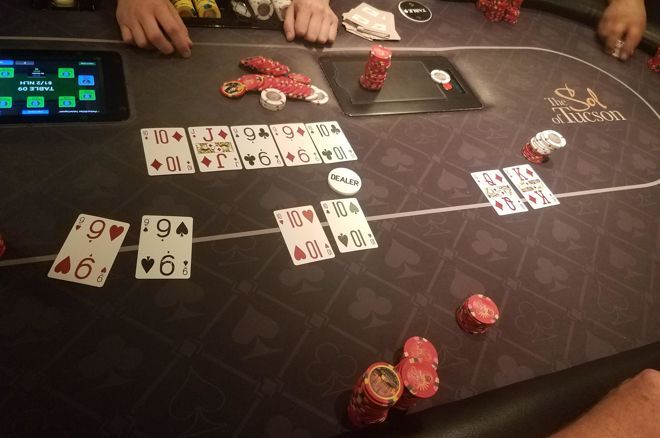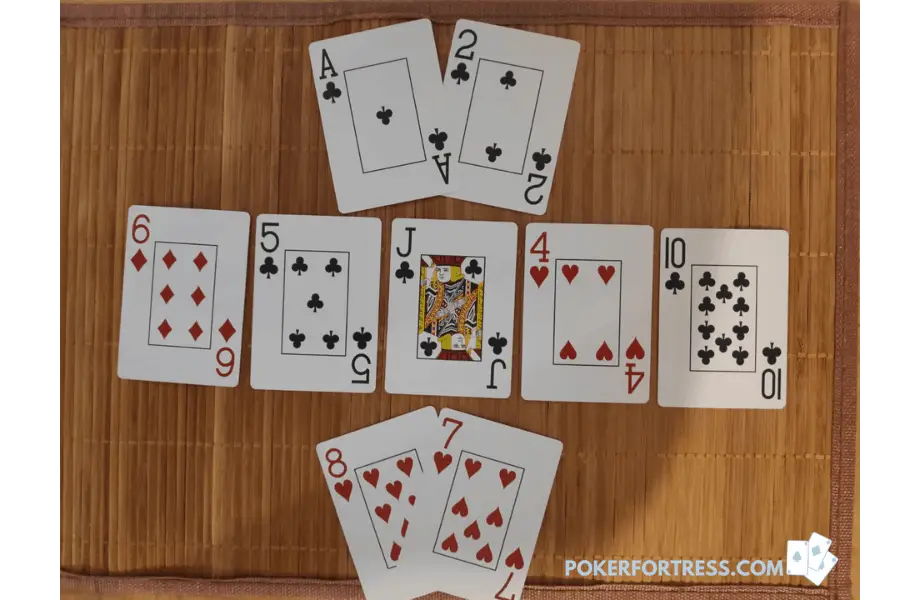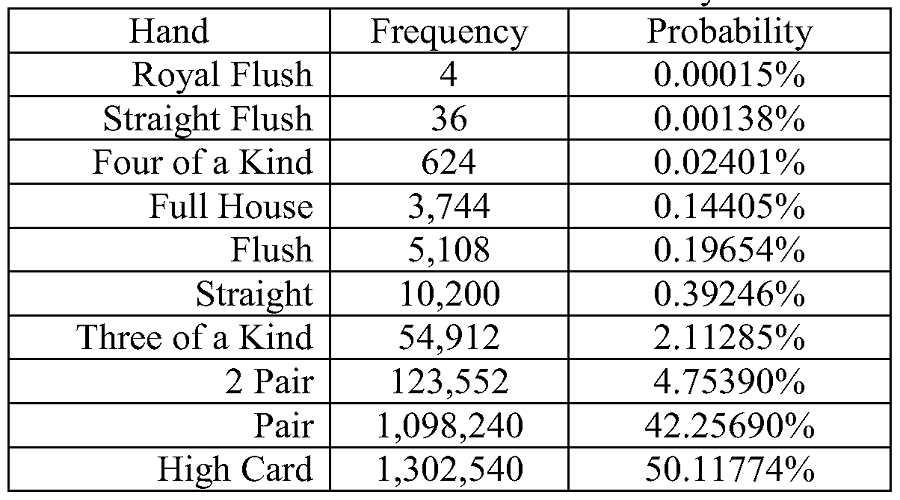Odds Of Straight Flush In Texas Holdem
- Full House
- Odds Of Texas Holdem Hands
- Odds Of Royal Straight Flush In Texas Hold'em
- Odds In Texas Holdem Chart
Whereas a pair floats by often enough, getting a straight or royal flush is less likely. 7 out of 52 means, that although you build your hand using 5 cards, you still have 7 cards from which to choose these 5. In the case of Texas Hold'em, there's the 2 pocket cards and 5 on the board. For all time of the game to me the straight flush came out only 3 times. All these 3 times were nuts. In order to win one straight flush from another straight flush - the probability of such a.
- Odds Straight Flush Texas Holdem Casino A pocket pair is cards of the same rank, which means if your two cards have the same number, from 2-2 all the way up to A-A, this is called a pocket pair. The odds of receiving any pocket pair is 5.9% which is 16 to 1.
- The worst case for a possible straight flush is holding something like A2s, AKs, A5s, etc., where there's only one possible way to flop the straight flush. In that case, the probability is one in 50C3, or 19600. The best case is 45s.TJs, which is 4 in 19600, because there are 4 ways to flop the straight flush.
Poker can be a fun card game for the family, or a serious competitive game in which the steaks can be so enormous, even selling your house wouldn’t cover the costs.
There are many variations of poker, with Texas Hold ‘Em being the most popular worldwide.
Below are a whole bunch of poker facts and statistics which help you understand the chances of wining and the odds of getting the cards you want.
Did You Know?
A pocket pair is cards of the same rank, which means if your two cards have the same number, from 2-2 all the way up to A-A, this is called a pocket pair.
- The odds of receiving any pocket pair is 5.9% which is 16 to 1. These are also the same odds of receiving a pocket pair of 2’s.
- The odds of receiving a specific pocket pair: 0.45% or 220 to 1 These are the same odds for receiving a pocket pair of A’s.
- The odds of receiving a pocket pair of A’s twice in a row is 0.002047% or 48,840 to 1.
- The odds of receiving a pocket pair of K’s is 0.9% which is 220 to 1.
- The odds of receiving a pocket pair of Q’s is 1.4% which is 73 to 1.
- The odds of receiving a pocket pair of J’s is 1.8% which is 54 to 1.
- The odds of receiving a pocket pair of 10’s is 2.3% which is 43 to 1.
- The odds of receiving a pocket pair of 9’s is 2.7% which is 36 to 1.
- The odds of receiving a pocket pair of 8’s is 3.2 which is 31 to 1.
- The odds of receiving a pocket pair of 7’s is 3.6% which is 27 to 1.
- The odds of receiving a pocket pair of 6’s is 4.1% which is 24 to 1.
- The odds of receiving a pocket pair of 5’s is 4.5% which is 21 to 1.
- The odds of receiving a pocket pair of 4’s is 5.0% which is 19 to 1.
- The odds of receiving a pocket pair of 3’s is 5.4% which is 17 to 1.
Poker Fast Facts
The total number of possible royal flush hands in a standard 52 card deck is 4.
And the odds of making a royal flush is 649,739 to 1.
This is correct assuming that every game plays to the river.
In poker terms, the river is the name for the fifth card dealt, face-up on the board.
In total, there are 2,598,960 possible poker hands with 52 cards.
The odds of getting four of a kind in Texas Hold ‘Em is 4164 to 1.
Casinos normally change decks after 15 minutes of steady play, so that the cards can always be fresh and unmarked, as many professional players would be able to remember the certain markings on cards and use that to their advantage.
This is only a basic overview of poker odds, there are many calculators online that can help solve the odds of getting certain hands, depending on what stage of the game you’re at, what cards you currently hold and how many people are playing.
Now you are familiar with these odds, you can use them to your advantage for a better poker strategy when you finally decided to play a tournament.
In Texas Hold-Em Poker the odds of making a royal flush hand is only 649,739 to 1.
Okay, so you know how to work out the odds for hitting a flush draw or a straight draw. In fact, every pot odds article you've ever read uses either a flush or a straight draw (or both if you're lucky) as their main example to help explain how it all works.
- The odds of hitting a flush draw on the turn are 4.2 to 1.
- The odds of hitting a straight draw on the turn are 4.9 to 1.
Easy stuff. But what if you're draw isn't a straight or flush draw? What about if your draw is a combination of both? Or how about if you're drawing to something unusual/random like four of a kind?
In this article I'll show you the method for working out the odds for uncommon draws in Texas Hold'em. I'll also throw in a bunch of examples for good measure.
The method for working out odds of random draws.
The method for working out unusual draws is exactly the same as the method for working out standard flush or straight draws.
You find out how many outs you have, then compare that number of outs to the number of cards that won't help you (e.g. “non-outs” : ”outs”).
Note: “Outs” are cards that will complete the draw you are chasing after. (e.g. if you are after the last Ace to make 4-of-a-kind, you only have 1 out).
The important part here is just find the number of outs you have. After you've figured that out, the rest is a doddle. If you're not familiar with the basic process, I'd highly recommend you have a read through the main pot odds article first. But for the rest of you, I'm going to use the following steps:
- Find out how many unknown cards there are in total.
- Find out how many outs we have.
- Make ratio of outs to non-outs.
- Simplify that ratio to make it easier to work with.
Examples of working out odds for different types of drawing hands.
1) Flush draw on the turn.
We'll start with something simple.

Our hand: A 2
Board: K 9 7 3
In this example, we have a flush draw, but we're on the turn instead of the flop. Therefore, there will be one less unknown card than usual to include in our workings out.
- Total number of unknown cards = 46
- 2 cards in our hand.
- 4 cards on the board.
- 52 (total number of cards in a deck) minus 6 = 46.
- Total number of outs = 9
- There are 13 hearts in the deck.
- 2 of them are in our hand.
- 2 of them are on the board.
- Ratio = 37:9
- Out of 46 unknown cards, if we take away 9 outs we are left with 37 unwanted cards.
- Simplified ratio = 4.1:1
Easy! The only difference that you have to remember in this example is that we are on the turn and not the river. As a result, there is one less “unknown” card left in the deck due to the fact that we can now see the turn card.

The majority of examples work out odds for when you're on the flop waiting for the turn, so I thought I'd do one for when you're on the turn waiting for the river.
2) Flush draw + inside straight draw on the flop.
Our hand: A 2
Board: K T Q
In this example we have a standard nut flush draw, but we also have an inside straight draw to boot.
- Total number of unknown cards = 47
- 52 minus 5 cards we can see (2 in our hand and 3 on the flop).
- Total number of outs = 12
- 9 hearts left in the deck.
- 3 jacks. Don't forget that the J has been included in the 9 hearts above for the flush draw.
- Ratio = 35:12
- 47 - 12 = 35.
- Simplified ratio = 2.9:1
The important part here is to remember that one of the jacks has already been included as an out for our flush draw. Many players make the mistake of believing that they have 9 hearts + 4 jacks, thinking they have 13 outs instead of 12.
Always double check to make sure that you're not including your outs twice when they can overlap like in this example.
3) Flush draw + 3-of-a-kind draw on the turn.
Our hand: A 2
Board: K 9 7 2
Let's say that we are confident that our opponent only has a pair or two-pair at best. Therefore, if we can improve our pair of twos to 3-of-a-kind, we will be able to win the hand (as well as if we are able to make a flush).
- Total number of unknown cards = 46
- Total number of outs = 11
- 9 hearts left in the deck.
- 2 twos.
- Ratio = 35:11
- 46 - 11 = 35.
- Simplified ratio = 3.2:1
This one's pretty straightforward. There are 2 twos left in the deck, and neither of them are hearts so we don't have to worry about these 2 outs overlapping with our flush draw outs.
4) Straight draw on the flop, and flush cards do not help us.
Our hand: Q J
Board: K T 2
In this example we have a common open-ended straight draw. However, the problem is that there is also a flush draw on the flop. We are confident that our opponent has either top pair (or better) or a flush draw. This means that we are not interested in continuing with our hand if another spade comes on the turn. Therefore, the A and 9 are not going to be considered as outs.

Full House
- Total number of unknown cards = 47
- Total number of outs = 6
- 8 straight draw outs in total (4 nines and 4 aces).
- Minus the A and 9 = 6.
- Ratio = 41:6
- 47 - 6 = 41.
- Simplified ratio = 6.8:1
Thanks to the flush draw cards our straight draw odds become a lot worse. We could just work out our normal straight draw odds including the spade cards (4.9:1) and then try to account for reverse implied odds as best as we can. However, this method is a lot simpler.

Final thoughts on working out odds for unusual draws.
Working out your odds of completing unusual draws and random types of hands all boils down to finding your total number of outs. After that, all you have to do is work through a small number of simple steps and you're done.
If you can figure out the exact number of outs you have, you'll never have a problem with odds.
Just remember:
- Find out how many outs you have.
- Make a ratio of non-outs to outs and simplify it.
Using this method you should be able to work out the odds in other random situations like:
- When the dealer accidentally flips over a card and has to burn it in a live game.
- When a player announces what cards they held before the hand is over.
- When you want to work out the odds of improving from 3-of-a-kind to 4-of-a-kind, because I mentioned it at the start of this article but didn't actually give an example (hint: you only have 1 out).
Odds Of Texas Holdem Hands
Note: After working your odds out you can compare your results with the list of odds found in the ratio odds chart.
Also, throughout this “unusual draws and their odds” article I've just worked out the ratio odds for different types of draws. If you're more comfortable using percentage odds, you can just use the same number of outs as before and use the rule of 2 and 4 to get a rough idea of your percentage odds.
Still struggling with playing flushes (and flush draws) in cash games? Try watching SplitSuit's strategy video on playing Flushes and Flush Draws.
Go back to the interesting Texas Hold'em Articles.
Can You Afford Not To Use
Poker Tracker 4?
Odds Of Royal Straight Flush In Texas Hold'em
“I wouldn’t play another session of online poker without it”
“I play $25NL, and in under 1 week PT4 had paid for itself”
Odds In Texas Holdem Chart
Comments